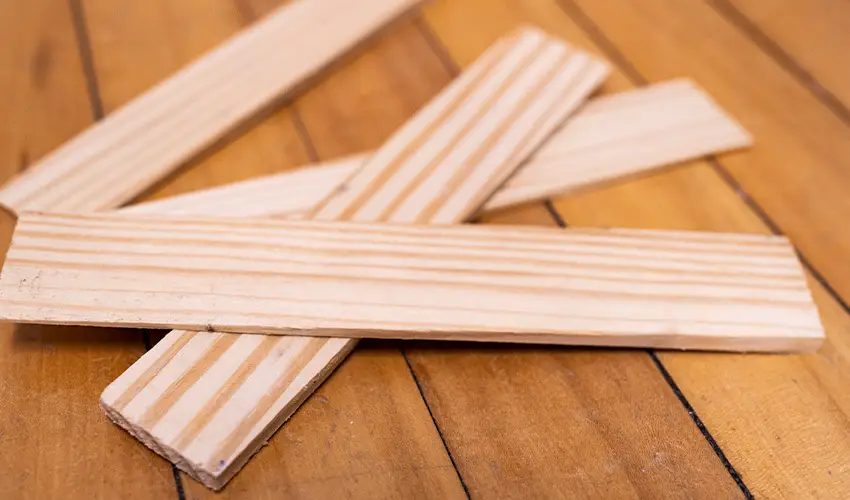
Simply put, a shim is a thinly-sliced tapered wedge used to adjust home elements such as windows and door frames, for alignment, tightly connecting the two surfaces, and filling the space between them. The shim is wedged between a frame and the adjoining stud to gradually level the element. From adjusting floorboards and subfloors to squaring up cabinets, removing cracks in outdoor decking, or levelling a shaky toilet, shims can be used for diverse purposes.
Assorted Shim Types Designed to Cater Diverse Needs
Shims come in several types due to their diverse uses. Let’s take a look at the most common shim types:
Wedge Shims: You can picture them as thin, wedged pieces of material (often plastic), utilized for filling gaps between objects to ensure a level, aligned, or optimal surface or connection.
Keyslot Shims: They are a thin, rectangular shim with a slot, designed to pivot around an anchor or bolt. Their usage ranges across diverse industries like precast, tilt-up, and glass, for leveling, aligning, and maintaining joint spacing.
Flat Plate Shims: These types of shims are thin as usual, but hard and made of metal or plastic plates. These are also used to fill small gaps or spaces between objects like the other shim types, offering support, leveling, or adjustment, and are often used in different machines, during construction, and other applications.
U-Shaped Shims: Also called horseshoe shims, these are designed with a U-shape to snap around screws, bolts, or other convex fixtures, allowing for adjustments without needing to detach the fixture.
Stackable Shims: Stackable shims are also thin, often tapered or wedged pieces of material like other shims. The only difference is that they are designed to be stacked together to achieve a specific thickness or fill a gap, essential for leveling, adjusting, or supporting objects.
For all the above-mentioned different types of shims, wood is the most common material used. The reason is the pine and cedar from which they are cut, making them perfect for almost any interior adjustment. Another popular choice is plastic shims, given that they are water and rot-resistant, making them perfect for plumbing or exterior adjustments.
Diverse Benefits of Using Shims
- Shims are important when adjusting the final fittings of cabinets, doors, windows, etc.
- They can facilitate easier assembly and disassembly of components.
- Shims can compensate for manufacturing disparities and tolerances, ensuring a stern and proper fit.
- They reduce errors and maximize operational efficacy by providing consistent spacing.
- They provide proper alignment, reducing stress and friction and preventing potential catastrophic failures of machine components. This also extends the equipment’s life and reduces the need for costly repairs or replacements.
- Shims can be made from different materials, i.e., plastic, metal, etc., and thicknesses, making them suitable for diverse applications, i.e., construction projects and industrial settings.
Picking the Right Shim: What to Do?
To pick the right shim, you first need to decide on its use for your project. Consider the following factors before choosing a shim:
- Consider the capacity of the shim to carry any static or vigorous loads.
- Consider the basic function that the shim serves, for instance, basic alignment correction, spacing adjustment, or load-bearing objectives.
- Consider the operating environment of the shim by including factors like humidity, exposure to chemicals, or temperature limits.
- Consider your budget and perform the cost-benefit analysis of diverse material choices.
- Consider non-conductive materials like plastic or certain composite shims if electrical isolation is required.
- Consider the readily available standard shim sizes provided by manufacturers, as personalized shims might need longer lead times and may yield potentially higher prices.
- Consider using a wooden shim for doors, windows, or trim work, allowing you to shape your shim to fill the exact space you need it to fill.
- Consider using a plastic or metal shim instead of a wooden one, if you need it for things like bathtubs, stone countertops, or other heavy objects. The reason is that the fibers of a wooden shim may break down over time.
Installing Shims: A Helpful Guide
- First, measure the gap where the shim is required, and use a level to check for any inconsistency.
- Choose the suitable shim material and thickness for the application, considering factors like weight, required fit, and environment. Make precise cuts in your shims using a utility knife or other appropriate tool, if it needs to be trimmed for a perfect fit.
- Carefully place the shim into the gap, ensuring it’s properly aligned and completely supports the objects it’s intended to align.
- For fastened applications, gradually tighten the screws or bolts while for friction-fit applications, tap the shim into place with a hammer or mallet until it’s securely seated.
- Use a level to confirm that everything is properly aligned, post-installation. Make fine adjustments if needed.
- Trim off any part of the shim that extends beyond the application area.
Mistakes to Avoid When Installing Shims
- Do not loosely place the shim otherwise it will move during the final installation, making whatever you’re trying to plumb, imbalanced or misaligned.
- Don’t use a wooden shim to install if you fear it being often exposed to water, or supporting something heavy. Use a plastic shim instead, which will hold up better over time.
- Don’t forget to secure your shim. Unsecured shims can drop or slip from their position, putting your materials at risk.
- Don’t over-tighten fasteners as this can mash or distort the shim, reducing its efficacy.
- Don’t forget to check the shim alignment and always verify with a level before securing it.
- Do not forget to trim extra shim material as puffed-up edges can create weak points or interfere with function.
Need Professional Help for Shim Installation?
Contact JD Handy Pro today at +1 571-831-2030 and acquire our emergency services for shim installation plus any other handyman solutions for your residential properties at market-competitive rates.


